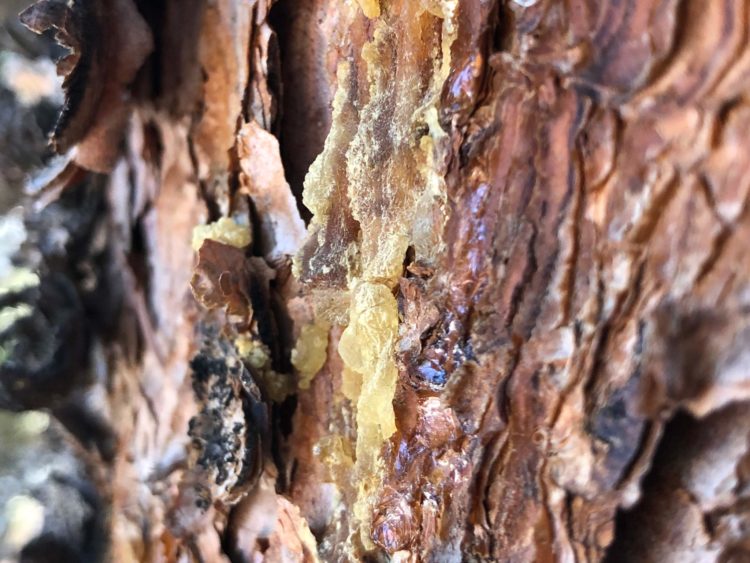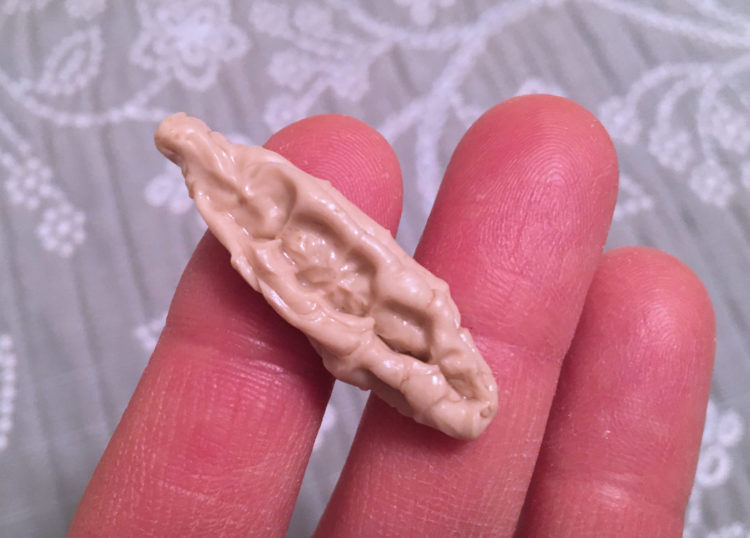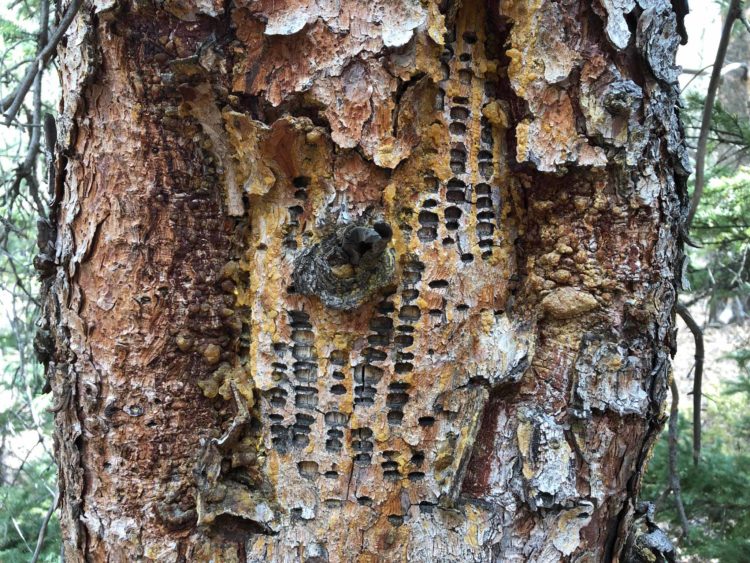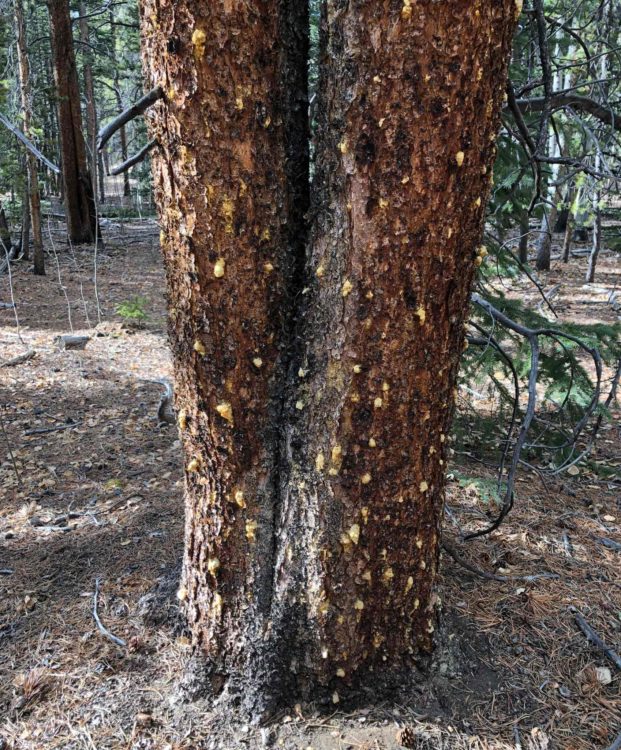
I am so taken with wild chewing gums lately. These are obtained from the resin or pitch that exudes from injuries to certain plants, that one can pry off and chew into waxy perfection.

Chewing gum from tree resins is a tradition that spans the globe—from the mastic gums or chios tears of the Mediterranean region, made from the mastic tree (Pistacia lentiscus); to the soft chicle of the Mayans from sapodilla (Manilkara zapote); to the once-popular spruce gum of the northeastern United States and Canada, made from black spruce (Picea mariana). When the wise men came bearing frankincense and myrrh for the infant Jesus, they were bringing resins—from trees in the genera Boswellia and Commiphora, respectively—which, in addition to incense and ceremonial use, are chewed like gum.

Ethnobotanical accounts from the West and Southwest name many different species of pines, spruce, fir, and mesquite whose pitch has been used for this purpose. These include the pinyon pines Pinus edulis and P. monophylla, ponderosa pine (P. ponderosa), lodgepole pine (P. contorta), Western white pine (P. monticola), gray pine (P. sabiniana), and sugar pine (P. lambertiana); white spruce (Picea glauca), Engelmann’s spruce (P. engelmannii), and Sitka spruce (P. sitchensis); grand fir (Abies grandis) and subalpine fir (A. lasiocarpa); and honey mesquite (Prosopis glandulosa) and velvet mesquite (P. velutina).

I would venture a guess that the resin of all pines, spruce, fir, and mesquite make for good chewing gum. To date I have had success with that of pinyon, ponderosa, lodgepole, bristlecone (P. aristata), and Engelmann’s spruce.
Tree resins have a long history of medicinal use against a number of ailments owing to their antimicrobial, anti-inflammatory, antioxidant, and immune-modulating properties. This makes sense because the trees produced the resin to fight an invader or injury. Science continues to investigate the traditional use of frankincense and myrrh against various cancers, although more clinical trials are needed. Much as I enjoy chewing wild gums for the sake of chewing, I also like to think I’m doing my body some added good.
In my early attempts at chewing tree pitch I went for the translucent, softer resins, only to coat my mouth and teeth in sticky goo that took no small amount of effort to remove. What you want for “field chewing” is dry pitch, which you can crack or snap apart, with a glassy break surface. Certainly pitch that doesn’t have attached bark or detritus is preferable, but I do not observe a quality difference in color. When you start chewing, it breaks apart into crumbly bits—and that’s a sign the pitch is dry enough. Then you have to work it with your mouth to get it to glom together into a gum. There may be off-flavors in the first few minutes of chewing, and those get spit out as you go, until you have a milder, waxy gum to chew.

One thing to note is that the dryness of the pitch can be more difficult to assess if it is frozen. Thus if I’m out in winter and I want to chew pitch without bringing it indoors to warm first, I bite cautiously. If it grabs the teeth after a few gentle chews, it’s too moist. Often you can still gingerly chew it without letting your teeth contact each other, but I usually discard the soft stuff and go for a better piece.
Flavors vary among tree species. I’ve heard black spruce gum is downright bubblegummy, although I have yet to try it. Our local trees are more piney or resiny in flavor. I’ll admit I’m not necessarily chasing amazing flavors here. I just enjoy chewing a piece of gum that wasn’t made in a factory, doesn’t coat my teeth with sugar, and is probably good medicine. Once I get a piece going, it can last an hour to a couple hours, although eventually it degrades into a crumbly mass that cannot be re-chewed into smoothness.
Thankfully, the trees provide plenty.

I can’t remember, did I stick frankincense and myrrh in your tea box? If so, did you try chewing those?
Hi dear deer, no frankincense and myrrh in the tea box, although it is probably for the best as I might have jumped straight out of my pants.
Where can I buy a resin chewing gum of myrrh and frankenscense of seperate flavors? I want the real thing. I have never tried them before, and have read about the great properties that they have. I do have myrrh in a capsule form, but I would also like some head on healing for my mouth. Thank you very much. Amy Mingee
Hi Amy, it’s funny, I am not sure where one might source those resins for chewing. I googled them, and found that you can buy the resins in their natural state, but they are being marketed for incense and some say “for external use only.” As for me personally, I would probably purchase the most authentic products and try chewing them. That said, I have not yet tried this, so I hesitate to recommend that unequivocally.
Ohhh, I’ve got a jar full of resin that I have planned to make some healing salve, I’m DEF going to give this a go.
Oh awesome! I’d love to hear what you think.
LOL, I find this article after my first newbie no experience attempt of pine chewing gum….. while I arduously try to scrap it off my teeth. I will be getting into the coconut oil for help as soon as I get home. Now I know better for round two, thanks!!
Ha ha, yeah, I did that myself. I hope you like it!
Hahaha, also here scraping resin off my teeth. Also, the strong bitter taste didn’t fade. That was rather unpleasant lol
Awesome info Amy. Went for a walk with the family and doggies today where I picked a nice piece of hard sap off a Pinyon Pine. An hour later it was still in my hand when I took a nap. I put it on my third eye thinking it may have healing properties. The life of the tree kind of thing. Now I get to pop it in my mouth because of you. Wishing you all the best. Brian
Howdy. I grew up 65+ years ago. Another kid I knew used to chew pine sap. I tried it. I’ve never forgotten it, so I did a search today and found your lovely article. Thanks for posting.
You are most welcome! Sincerely, Erica